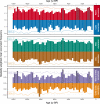The 4.2 ka event is not remarkable in the context of Holocene climate variability
- PMID: 39095415
- PMCID: PMC11297131
- DOI: 10.1038/s41467-024-50886-w
The 4.2 ka event is not remarkable in the context of Holocene climate variability
Abstract
The "4.2 ka event" is a commonly described abrupt climate excursion that occurred about 4200 years ago. However, the extent to which this event is coherent across regional and larger scales is unclear. To objectively assess climate excursions in the Holocene we compile 1142 paleoclimate datasets that span all continents and oceans and include a wide variety of archive and proxy types. We analyze these data to determine the timing, significance and spatial imprint of climate excursions using an objective method that quantifies local, regional and global significance. Site-level excursions in temperature and hydroclimate are common throughout the Holocene, but significant global-scale excursions are rare. The most prominent excursion occurred 8200 years ago, when cold and dry conditions formed a large, significant excursion centered in the North Atlantic. We find additional significant excursions between 1600 and 1000 years ago, which agree with tree-ring data and annual-scale paleoclimate reconstructions, adding confidence and context to our findings. In contrast, although some datasets show significant climate excursions 4200 years ago, they do not occur in large, coherent spatial regions. Consequently, like most other periods in the Holocene, the "4.2 ka event" is not a globally significant climate excursion.
© 2024. The Author(s).
Conflict of interest statement
The authors declare no competing interests.
Figures




References
-
- Laepple, T. et al. Regional but not global temperature variability underestimated by climate models at supradecadal timescales. Nat. Geosci.16, 958–966 (2023).10.1038/s41561-023-01299-9 - DOI
-
- Alley, R. B. et al. Abrupt Climate Change. Science299, 2005–2010 (2003). - PubMed
-
- Williams, J. W., Blois, J. L. & Shuman, B. N. Extrinsic and intrinsic forcing of abrupt ecological change: case studies from the late Quaternary. J. Ecol.99, 664–677 (2011).10.1111/j.1365-2745.2011.01810.x - DOI
-
- National Research Council. Abrupt Impacts of Climate Change: Anticipating Surprises. (National Academies Press, 2013).
-
- Dansgaard, W., Oeschger, H. & Langway, C. C. Ice core indications of abrupt climatic changes. in Palaeoclimatic Research and Models (ed. Ghazi, A.) 72–73 (Springer Netherlands, Dordrecht, 1983). 10.1007/978-94-009-7236-0_9.
Grants and funding
LinkOut - more resources
Full Text Sources

